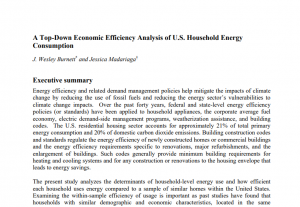Full Title: A Top-Down Economic Efficiency Analysis of U.S. Household Energy Consumption Executive Summary
Author(s): J. Wesley Burnett and Jessica Madariaga
Publisher(s): International Association for Energy Economics
Publication Date: March 1, 2018
Full Text: Download Resource
Description (excerpt):
Energy efficiency and related demand management policies help mitigate the impacts of climate
change by reducing the use of fossil fuels and reducing the energy sector’s vulnerabilities to
climate change impacts. Over the past forty years, federal and state-level energy efficiency
policies (or standards) have been applied to household appliances, the corporate average fuel
economy, electric demand-side management programs, weatherization assistance, and building
codes. The U.S. residential housing sector accounts for approximately 21% of total primary
energy consumption and 20% of domestic carbon dioxide emissions. Building construction codes
and standards regulate the energy efficiency of newly constructed homes or commercial buildings
and the energy efficiency requirements specific to renovations, major refurbishments, and the
enlargement of buildings. Such codes generally provide minimum building requirements for
heating and cooling systems and for any construction or renovations to the housing envelope that
leads to energy savings.
